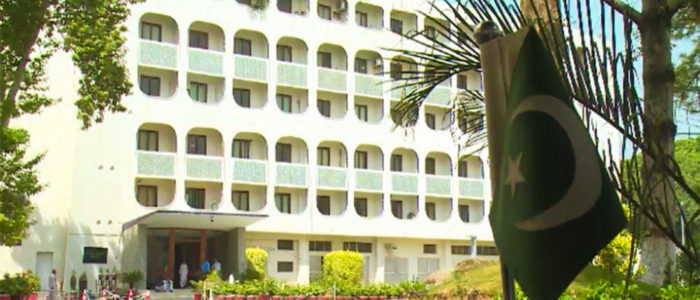As Pakistan braces for traditional power-play in its neighbourhood along with the emergence of advanced and unregulated technologies, there are legitimate concerns about the existing organisational structure of the Foreign Office (FO). The FO’s existing divisions are based on archaic groupings and consist of several lacunae. More importantly, there is a shallow understanding about a geostrategic outlook with which Islamabad views the world.
While India has already revamped its Ministry of External Affairs in accordance with long-term geostrategic alignments and technological diplomacy, Pakistan’s FO appears comfortable with the status quo; the passivity poses a dilemma which could incur consequences of strategic significance.
Islamabad remains fixated with the ‘Middle East’ as a distinct sub-regional construct, conveniently ignoring the fact that since the early days of the so-called ‘Arab Spring’, geopolitics in North Africa (especially Libya and Egypt) are closely intertwined and impacted with those in the GCC bloc (Kingdom of Saudi Arabia, United Arab Emirates and Qatar). In turn, North Africa and GCC are now caught in a larger Mediterranean battleground where Turkey features commonly between the Israel/Greece/Cyprus bloc on the one end and Libya/Egypt bloc via the Red Sea on the other.
On the Asian front, Pakistan’s FO presently groups Afghanistan/Iran/Turkey together into one division. There are three distinct divisions with overlapping mandate such as South Asia Division (which primarily focuses on India and SAARC), the Central Asian Republics and Economic Cooperation Organisation Division (CARs and ECO) and Shanghai Cooperation Organisation (SCO) Division.
There is a need to re-orient and restructure the FO at least once per decade so that diplomatic manoeuvering in accordance with evolving geostrategic and geoeconomic dynamics can yield positive results.
The signing of landmark CPEC ties Pakistan’s long-term future with China’s BRI; consequently, it would not be unwise if a separate ‘Belt & Road Division’ is created. After all, Pakistan has the unique advantage of being the only node which links both the maritime and Central Asian routes of this mammoth Chinese project. Establishing a Belt & Road Division would place Pakistan on a decisive influential position for engagement with member states from a geoeconomic angle.
As far as the ‘Middle East’ is concerned, the undeniable reality is that Arab Gulf countries do not have a unified socio-political outlook. Qatar and Oman have outlooks distinct from the remaining GCC countries. Qatar is part of Turkey’s unique and assertive geostrategic paradigm while Oman remains equally close to Iran, despite the recent change in leadership. A Turkey-Qatar-Iran trilateral along with Qatar-Iran and Oman-Iran blocs have one common binding factor: Iran. In the ‘Middle East,’ therefore, Turkey and Iran are potent alternatives to the KSA-UAE-Bahrain bloc. A proper alternative is the establishment of a ‘West Asia’ Division which would include West Asia-I (Turkey/Iran), West Asia-II (GCC) and West Asia-III (Qatar/Oman).
There is a need to re-orient and restructure the FO at least once per decade so that diplomatic manoeuvering in accordance with evolving geostrategic and geoeconomic dynamics can yield positive results.
Regarding the ‘Indo-Pacific’ concept, Pakistan’s FO should firmly rebuff attempts by certain countries to hyphenate the Indian and Pacific oceans. A firm and consistent narrative should be upheld that Pakistan views the Indian Ocean absolutely distinct from the traditional notion of Asia Pacific region. Regrettably, Pakistan has never had any specific division to deal with Indian Ocean countries and littorals excluding the South Asia Division. The establishment of an Indian Ocean Division is imperative, with Indian Ocean (West) to oversee engagement with East African and Western Indian Ocean countries and Indian Ocean (South) to focus on Sri Lanka, Mauritius, Maldives, etc. Similarly, a separate Asia Pacific Division is necessary for coordination with Asia Pacific (West) i.e. Indonesia, Malaysia and Southeast Asian counties and Asia Pacific (East) for engagement with Japan, the Philippines and other island countries in the Far East.
Pakistan’s FO has a dedicated China Division but does not have a similar entity to deal exclusively with Russia (Russia Division). What Islamabad needs to be mindful of is that there should not be acknowledgment of a ‘Eurasian’ concept as it encourages support for a fascist agenda propounded by Aleksandr Dugin, an ideologue considered as the brains behind President Vladimir Putin’s expansionist agenda in Crimea, Donetsk and elsewhere. Pakistan’s growing relations with Ukraine and Belarus will be spoiled if they are grouped with Russia. Regarding CARs, all those countries should be reorganised within the existing SCO Division. It is only logical that Pakistan deals with CARs from the Sino-Russian (SCO) perspective.
Rather than setting up a new Technologies Division to handle Cyber and Telecom issues, the scope of existing Legal and Treaties Division should be expanded to include legal experts with certified domain expertise in Cyber, Outer Space, Maritime Affairs, Emerging Technologies, Telecom and the like.
The Government of Pakistan should encourage the FSP cadre to carve a ‘new outlook’ toward the world and adjust accordingly. The key to success lies in basing these efforts upon a purely indigenous geostrategic identity or ‘prism’ to inspire bureaucratic manoeuvering. Adherence to the status quo is ill-advised.
